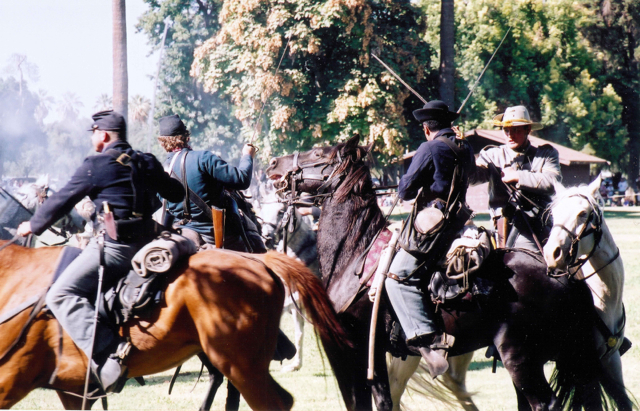Kearney Park and Mansion
PHOTO BY ADAM BLAUERT
M. Theodore Kearney
During the mid-1800’s, the majority of people who visited the San Joaquin Valley couldn’t see the agricultural potential that would be unleashed through irrigation.
M. Theodore Kearney was one of the few who did and although his name may not be a household one, he played a major role in making the valley what it is today. The most visible legacies of his life are Fresno’s Kearney Mansion and Kearney Park.
Kearney started in 1875 by promoting and managing colony development systems in Fresno County. Land was subdivided and sold with irrigation and fencing provided, making grape and fruit growing both possible and affordable for middle class families.
1883
In 1883 he began his biggest project – the Fruit Vale Estate. Kearney purchased 6,800 acres west of Fresno with the intention of making it the greatest agricultural colony yet established in the area.
Simply raising the investment capital to undertake the massive project – especially the irrigation system – required a three year trip to New York and Europe.
Work began as soon as he returned. Kearney selected 240 acres on the southern edge of his property for a park and grand estate that would serve as his headquarters.
He commissioned well-known landscape artist Rudolph Ulrich to design “Chateau Fresno Park” in what was then a barren plain. Within a few years the barrenness had been transformed into what was probably the best collection of trees, vines, shrubs, and roses in the United States.
Chateau Chenonceaux
In the center of it all, Kearney planned to build a five-story mansion based on the Chateau Chenonceaux in Tours, France. This ambitious plan was the culmination of the remarkable social and economic climb of a man who kept his working-class Irish immigrant background a closely-guarded secret in a time when it was not “respectable” to be Irish.
The chateau would be a place where Kearney could proudly entertain his European investors and friends.
Kearney’s death in 1906 kept the chateau from being constructed. Kearney had been living in a large home on the property that was ultimately intended to be the Superintendent’s Lodge, a home for the ranch manager.
UC
Kearney willed his property to the University of California and the Lodge, now known as the Kearney Mansion, was used by the University until 1962. At that point the Fresno Historical Society began to transform it into a museum.
The home has now been a museum for over 50 years. Several restoration projects during that time period have returned it to its original appearance.
Over 70% of the furnishings and décor are original
The others have been matched from old photographs. Constructed in a French Renaissance style out of local materials, the mansion’s two-foot thick outer walls are actually plaster-covered adobe bricks.
Hour-long tours of the Kearney Mansion are offered Friday, Saturday, and Sunday at 1, 2, and 3PM. Tour guides are knowledgeable and you will learn a lot about the history and development of our valley during your visit. While in the “mansion” you can see images of what Kearney’s planned chateau would have looked like.
If you’re interested in learning more you can pick up a copy of M. Theo Kearney: Prince of Fresno in the gift shop. Eventually the Fresno Historical Society plans to create a larger museum at the site to tell the story of the San Joaquin Valley and its people.
Admission to the mansion is $5 for adults, $4 for seniors, students with ID, and youths 13-17, and $3 for children 3-12. Children under 3 are free. Special Christmas tours are offered in December.
For more information
or call (559) 441-0862.
An additional $5 is charged by the County of Fresno to enter the park. The park is open during daylight hours. In addition to the mansion, the park offers:
Shaded picnic tables and reservable group picnic shelters
Playgrounds
Soccer fields
Softball diamonds
Horseshoe pits
Annual Kearney Park events include
September: Highland Gathering and Gameshttp://www.scottishsociety.org/index.php?option=com_content&view=article&id=52&Itemid=55
October: Civil War Reenactment http://www.valleyhistory.org/index.php?c=19
November: Kearney Park Renaissance Faire http://www.kearneyrenaissancefaire.com/
For more information about Kearney Park, go to http://www2.co.fresno.ca.us/4510/4360/Parks/parksresvinfo.htm
Location
To get to Kearney Park from Merced County, head south on Highway 99, exiting at Grantland. Follow Grantland south for 7 miles until it ends at Kearney Boulevard.
Turn left and watch for the park entrance on the right. The palm and eucalyptus trees around the park were planted by Kearney. They line Kearney Boulevard all the way into downtown Fresno where Kearney ends at Fresno Street.
Other historic home museums within an hour’s drive of Merced County include
Sources:
Rehart, Schyler and William K. Patterson. M. Theo Kearney: Prince of Fresno. Fresno: Dumont, 1988.
http://www.valleyhistory.org/index.php?c=58
http://historicfresno.org/nrhp/kearney.htm
http://www.scottishsociety.org/index.php?option=com_content&view=article&id=52&Itemid=55







Adam Blauert, a high school teacher and avid outdoors enthusiast, has dedicated the majority of his life to Merced County. His passions include fishing, backpacking, delving into local history, and exploring the wonders of the western states.